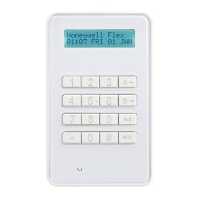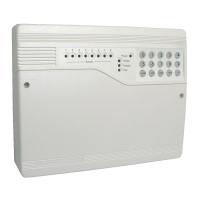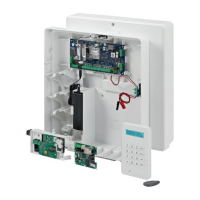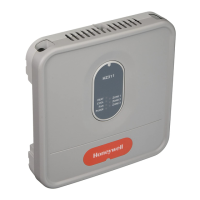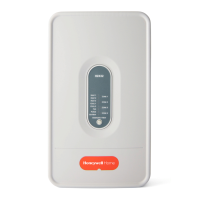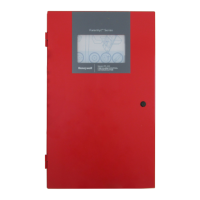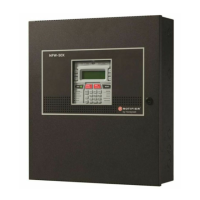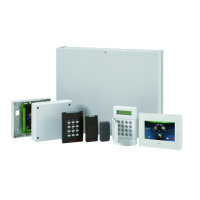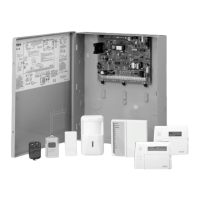
Do you have a question about the Honeywell OMNI 408 and is the answer not in the manual?
| Model | OMNI 408 |
|---|---|
| Keypads Supported | Up to 8 |
| Event Log | Yes |
| Input Voltage | 16.5 VAC |
| Compatibility | Honeywell security systems |
| Display | LCD |
| Communication | Phone line, cellular |
| Power Supply | 16.5VAC |
| Zones | 8 |
Overview of the OMNI-408 security system, its features and capabilities.
Important information and symbols used within this manual for installation and operation.
Guidance on connecting the OMNI-408 control panel, including diagrams and standards.
Detailed description of each terminal on the OMNI-408, its function, and wiring requirements.
A worksheet to calculate the total current draw of auxiliary devices connected to the system.
Step-by-step instructions for physically mounting the main control board within its enclosure.
Procedures for installing the RF receiver module and its antennas to the control panel.
Explanation of the system's behavior upon initial power-up and how to perform a system reset.
Information on the types of keypads supported by the OMNI-408 system and their compatibility.
Details on the function and behavior of the keypad's built-in sounder for system events.
Configuration options for the keypad backlight timer, including always-on or timed operation.
How to assign unique addresses to keypads connected to the control panel.
Procedures for arming the security system in various modes like Away, Stay, and Instant.
How to reset the system after an alarm condition or trouble, including fire alarm reset procedures.
Instructions on how to temporarily bypass specific zones to allow arming when zones are faulted.
Method for bypassing multiple zones sequentially without re-entering the user code.
How to bypass zones quickly without needing a user code, if enabled.
Explanation of the Exit Bypass feature, which bypasses faulted zones at the end of the exit time.
Automatic unbypassing of bypassed zones upon system disarm.
Procedure for manually removing a zone bypass.
Steps for programming or modifying user codes for system access and control.
How to delete user codes from the system, excluding the Master User code.
Description of how to activate and the system's response to keypad emergency conditions like Panic or Fire.
Information on how events are displayed on a pager when the Follow-Me feature is used.
Instructions on how to program a pager follow-me phone number into the system.
A list of quick commands available to the end user for system operations.
Procedure for quickly arming the system without a user code, if programmed.
Procedure for quickly arming the system, bypassing faulted zones, if programmed.
How to set the system's internal clock and date via the keypad.
Function to display zone numbers and descriptors on an LCD keypad.
How to turn the zone chime feature on or off for the entire system.
Function to display the current date and time on an LCD keypad.
How to toggle the pager feature for open/close events on or off.
Procedure for initiating an on-line download session with the central station.
Steps required to access the different installer modes for system configuration.
Mode for programming system options directly via the keypad.
A mode that allows viewing programmed information without making changes.
How to perform system downloads remotely without operator presence.
Procedure for initiating an on-line download session with the central station.
Mode used for testing RF receiver performance with reduced gain.
A function to clear system tamper displays that have been restored.
Accessing and viewing the system's event history log.
Overview of system programming methods, keypad vs. downloader, and default settings.
Detailed explanation of each programming question for system configuration.
Configuration options for defining zone types, options, and alarm codes.
Procedures for entering serial numbers for RF devices like transmitters and keyfobs.
Configuration of functions for each button on the RF keyfobs.
Introduction to entering data via different keypad types and interpreting display information.
Instructions for performing programming using an LED keypad, including mode entry.
Instructions for performing programming using an LCD keypad, including mode entry.
Instructions for performing programming using a Fixed-Word keypad, including mode entry.
A quick reference guide summarizing the keystrokes for programming operations.
A summary of all user-operable functions and their corresponding keypad commands.
A list of installer modes and the keypad sequences to access them.
Description of the standard reporting format, including account number and event codes.
Description of the extended reporting format for more event codes and zone identifiers.
Description of the partial extended format, combining standard and extended reporting.
Description of the 3x2 or 4x2 reporting format, an alternative to extended format.
Description of the 4x2 Express reporting format, known for speed and parity transmission.
Description of the ADEMCO Point ID format, supporting extensive event codes and zone identifiers.
Important warnings and limitations regarding the system's protection capabilities and potential failure points.
FCC and Industry Canada statements regarding radio frequency emissions compliance.
FCC and Industry Canada statements regarding telephone and modem interface compliance.
Details of the product's limited warranty, including coverage, duration, and exclusions.

